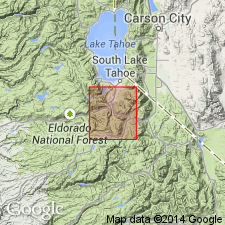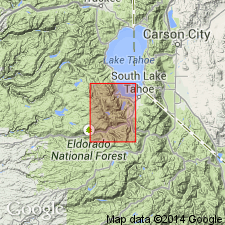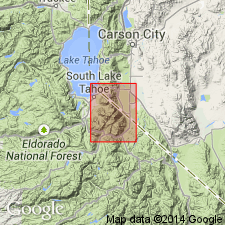
- Usage in publication:
-
- Bryan Meadow Granodiorite*
- Modifications:
-
- Adopted
- Age modified
- AAPG geologic province:
-
- Sierra Nevada province
Summary:
Bryan Meadow Granodiorite. Occurs in central Sierra Nevada of California. Consists of light-gray, medium-grained, locally porphyritic hornblende biotite granodiorite. Intrudes Echo Lake Granodiorite, the Burnside Lake Adamellite of Parker, 1961 (GSA Bull., v. 72, p. 1789-1805), the granodiorite of Freel Peak, the informal Lovers Leap granodiorite of Loomis (1981), and quartz diorite of Jobs Canyon. Evernden and Kistler (USGS Prof. Paper 623, 1970) report biotite K-Ar ages of 87.4 +/-2 Ma and 87.4 +/-2 Ma (89.6 +/-2 Ma and 89.3 +/-2 Ma, respectively, using the new IUGS constants of Steiger and Jager, 1977, Earth Planet. Sci. Letters, v. 36, p. 359-362). Age is Late Cretaceous. Type locality designated. Bryan Meadow Granodiorite here adopted by the USGS.
Type locality: exposures north of Elbert Lake, in sec. 19, T. 11 N., R. 18 E., [Echo Lake 7.5-min quadrangle, El Dorado Co., northern CA].
Source: GNU records (USGS DDS-6; Menlo GNULEX).

- Usage in publication:
-
- Bryan Meadow granodiorite
- Modifications:
-
- Named
- Dominant lithology:
-
- Granodiorite
- AAPG geologic province:
-
- Sierra Nevada province
Summary:
Described and shown on map of Fallen Leaf Lake 15' quad, El Dorado Co, CA, where unit is exposed over 25 to 30 sq mi within quad and extends few mi to both east and south of quad. Intrudes Echo Lake, Lovers Leap, and Desolation Valley granodiorites and Keiths Dome quartz monzonite. Apparently intruded by mafic quartz diorite body. Remarkable for large gradational variations in composition and color. Contacts are difficult and age relations uncertain. Map shows unit as of Cretaceous age.
Source: GNU records (USGS DDS-6; Menlo GNULEX).

- Usage in publication:
-
- Bryan Meadow Granodiorite*
- Modifications:
-
- Mapped
- Geochronologic dating
- Dominant lithology:
-
- Granodiorite
- AAPG geologic province:
-
- Sierra Nevada province
Summary:
Bryan Meadow Granodiorite. Light-gray, medium-grained hypidiomorphic-granular granodiorite. A more leucocratic, silicic phase of this pluton is mapped in vicinity of Horsethief Canyon and Horse Meadow (stippled pattern). K-Ar biotite ages of 87.1 +/-2 and 87.4 +/-2 Ma are reported by Evernden and Kistler (USGS Prof. Paper 623, 1970) for a sample of Bryan Meadow Granodiorite collected in Horsethief Canyon (89.3 +/-2 and 89.6 +/-2 Ma, respectively, using decay constants of Steiger and Jager, 1977, Earth Planet. Sci. Letters, v. 36, p. 359-362). Age is Late Cretaceous.
Source: Publication.
For more information, please contact Nancy Stamm, Geologic Names Committee Secretary.
Asterisk (*) indicates published by U.S. Geological Survey authors.
"No current usage" (†) implies that a name has been abandoned or has fallen into disuse. Former usage and, if known, replacement name given in parentheses ( ).
Slash (/) indicates name conflicts with nomenclatural guidelines (CSN, 1933; ACSN, 1961, 1970; NACSN, 1983, 2005, 2021). May be explained within brackets ([ ]).

